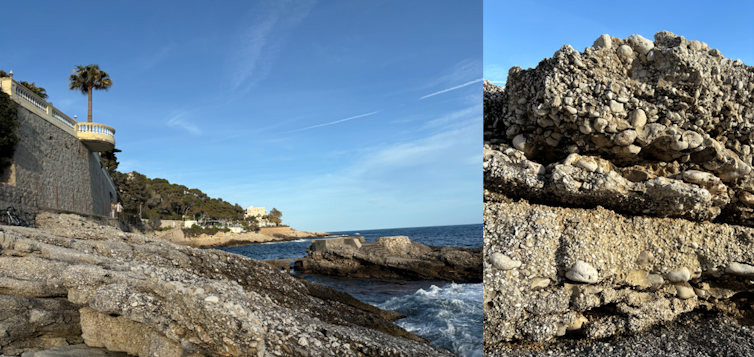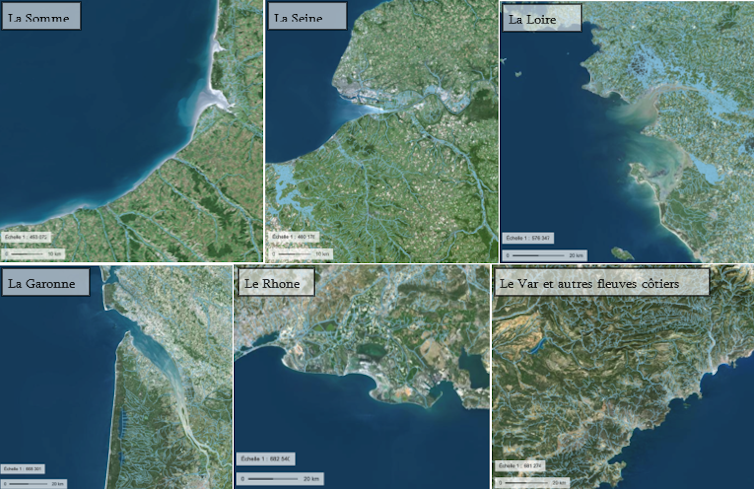You're bound to have a preference between fine sand and pebbles, but how are these beaches formed? Sawyer Specter/Unsplash, CC BY
For the lucky ones taking part in the summer crossroads, this question undoubtedly evokes a priority criterion in the choice of vacation destination. What are the processes behind a deposit, whether of sand or pebbles?
A sedimentary deposit corresponds to the transport of elements resulting from the alteration of rocks on the continent, and their sedimentation in a suitable environment, in this case the seashore. Whether sand or pebbles, they correspond to sediments with different grain sizes. Let's skip over the borderline between these two types of deposit, to avoid debating numbers, and rely on the experience of each to contrast a fine sand deposit with a pebble deposit.
Evidence of transport and deposition environment
Under certain favourable conditions, it is possible to observe fossilized beach deposits whose vertical succession of layers enables us to grasp the variation in depositional conditions over time.

In this way, we can deduce that the same environment, over a few tens of thousands of years, may have successively presented very different landscapes, from sandy to pebbly beach, or even an unwelcoming cliff foot. The deposit is therefore under the control of one or more evolutionary parameters.
Closer inspection of these sediments reveals numerous clues to their origin and transport. Whereas a deposit of small, blunt pebbles suggests a long transport that favored their fragmentation and polishing, a deposit of slightly blunt boulders indicates a factory with little transport.
This underlines the need to consider the mode of transport. During a collapse, a boulder resulting from the fragmentation of a cliff is easily moved a few hundred meters from its source, depending on the slope encountered along the way.
But how can we understand deposits far from the source? Observation of present-day processes provides information on the origin of ancient deposits. Watercourses are vectors for transporting rock fragments that weather at varying distances from the shoreline. This transport from the source is called erosion. Transport times have been studied, ranging from a single flood event (massive long-distance transport) to several tens of thousands of years.
Once transport is complete, the fragments are deposited in an environment that is sufficiently calm for them to undergo no further significant displacement. Calm locations are ideal for deposition, and the calmer the environment, the more fine fragments can settle out, forming the typical landscapes of bays and coves.
Conversely, seafronts where the swell is powerful are not good depositional environments. Sedimentation is unstable and the coastline is bare rock, subject to the relentless onslaught of high-energy waves. It's a recurring feature of the headlands and island fronts in the wind.
It's all a question of the mechanical energy involved in the circulation of water on the Earth's surface. As it flows from its source to its mouth, water loses potential energy, which is partly converted into kinetic energy. Far upstream, the river adopts a steep gradient, where the energy involved is high and mobilizes the most massive fragments. Downstream, the river widens and slopes become gentler. The water loses its energy. Larger fragments are deposited in the bed, and only the smaller ones remain mobile... and so on. At the end of the day, we can see along the watercourses, the result of a classification of the fragments.

This classification is complete when the river bed crosses low-lying valleys whose topography is marked by a very gentle gradient. The total development of the watercourse is also often a good indicator of classification. Well-developed, the grading leaves only the sand to reach the mouth. For proof of this, just compare satellite photos of the mouths of our main rivers. While major rivers discharge large quantities of fine sediments into the sea, observation shows that south-eastern France escapes the rule.
Take the extreme case of the Nice region. No major river ensures the consistent supply of beach deposits. Another peculiarity is that all coastal rivers have exceptionally steep gradients. This is because the Nice region is mountainous. The Argentera massif, located 50 km from the coast, reaches an altitude of over 3,000 metres. The energy of the rivers that originate here is maintained right up to their mouths. The classification is therefore incomplete, and the deposits that reach the sea are coarser and more heterogeneous.
Reflecting the local to regional geological context
So we're beginning to sketch out an answer to the question posed. But a detour into chemistry is necessary to appreciate the complexity of the processes involved. Sand appears on our beaches when the coarse products of erosion are deposited on the continent in river beds. Where this is not the case, these coarse elements contribute to the sedimentation of the seashore. At this point, we should point out that pebble beaches are not beautiful, homogeneous deposits, but the result of mixing.
This presupposes that rivers carry coarse "pebble-like" fragments, but that they also carry a finer granulometric fraction that gives rise to sands. In fact, rivers transport fragments of the rocks that make up their watersheds. And the least we can say is that not all rocks behave in the same way when exposed to water.
As an alteration agent, water is a solvent. As it penetrates rock fractures, it gradually modifies the chemistry of the minerals, bringing some of their constituent atoms back into solution in the form of ions, or taking part in their composition. As a physical agent, water's variations in volume, controlled by its temperature, also accomplish a veritable tour de force in the fractures, which they gradually enlarge. In short, water is a simple body with complex properties, which fractures and modifies the composition of the rocks over which it flows and into which it seeps.

There's only one mineral that tirelessly resists the onslaught of water: quartz. As a result, any rock containing quartz crystals (granite, sandstone, etc.) will be subject to fragmentation, but will ultimately produce a fine deposit of independent grains known as sand.
The impact of climate
Our beaches are the result of the deposition of the products of continental rock erosion. Carried away by rivers, the fragments, whose nature and grain size are linked to the regional geology, are sorted in order of size, according to the profile of the river. The products arriving at sea are then deposited on the coastline, depending on the local energy brought into play by waves and currents. Considering all the dynamic processes involved, it's easy to understand how such a deposit can evolve over short geological timescales, of the order of a thousand years.
The history of our beaches is therefore essentially controlled by water. It seems appropriate to question the impact of parameters controlling the water cycle on beach distribution. In 2018, a team of Dutch researchers working on a satellite imagery processing tool proposed a global synthesis of coastlines occupied by sandy beaches.
In other words, climate plays a major role in the distribution of our sandy beaches. This is hardly surprising, as long as we understand that the conditions of water transport determine the nature of downstream beaches. Subject to continuous and abundant rainfall, the intertropical convergence zone has a very gentle relief profile, dislocated by intense erosion. Slopes are gentle and the grading of transported fragments maximum, so that sand is deposited well before the edge of the continent. At the seaside, beaches concentrate even finer fragments, the clays that form the soil of mangroves. At our latitudes and in tropical zones, erosion is less intense, and sandy beaches are concentrated there. As for pebble deposits, they are ultimately the result of very local contexts. The possible impact of climate disruption on the distribution of sandy beaches is thus only hinted at.
Let's end with a wink that made the rounds on the web in 2018 - that's an eternity! A team of Anglo-Saxon researchers has investigated the origin of the white sands surrounding warm sea islands. A mystery that can't be explained in our article, as none of the rocks on these islands could have yielded such sediments. These deposits, which make up the foreground of the most beautiful beach photos, were in fact derived from the surrounding coral. But here, water was not the predominant factor in the alteration. It was a biological agent, the parrotfish and its fascinating beak, a veritable coral grazer, that ensured the supply of sand. The fish grinds up the animal's skeleton and its digestive tract sorts it out. The sand is then a waste product that is washed ashore by the waves. A single individual can produce 100 kilos of sand per year. That's enough to restore the reputation of our beautiful beaches, each grain of which is a breath of fresh air in the long history of our mountain ranges.![]()
Fabrice Jouffray, Doctor of Geosciences, Université Côte d'Azur
This article is republished from The Conversation under Creative Commons license. Read theoriginal article.
THE CONVERSATION
Université Côte d'Azur, through its Science and Society department, joined "The Conversation" online news media in January 2022. The aim is to showcase the work of our research teams in the service of informed, reliable information that contributes to civic debate.
The Conversation is an online medium and a non-profit association. Its model of collaboration between experts and journalists is unique: to share knowledge, making the voice of researchers heard in the public debate, and enlightening the news with reliable, research-based expertise.
theconversation.com
SUBSCRIBE NOW!
To keep up with The Conversation experts on a daily basis, subscribe to our newsletter.
theconversation.com/en/new




